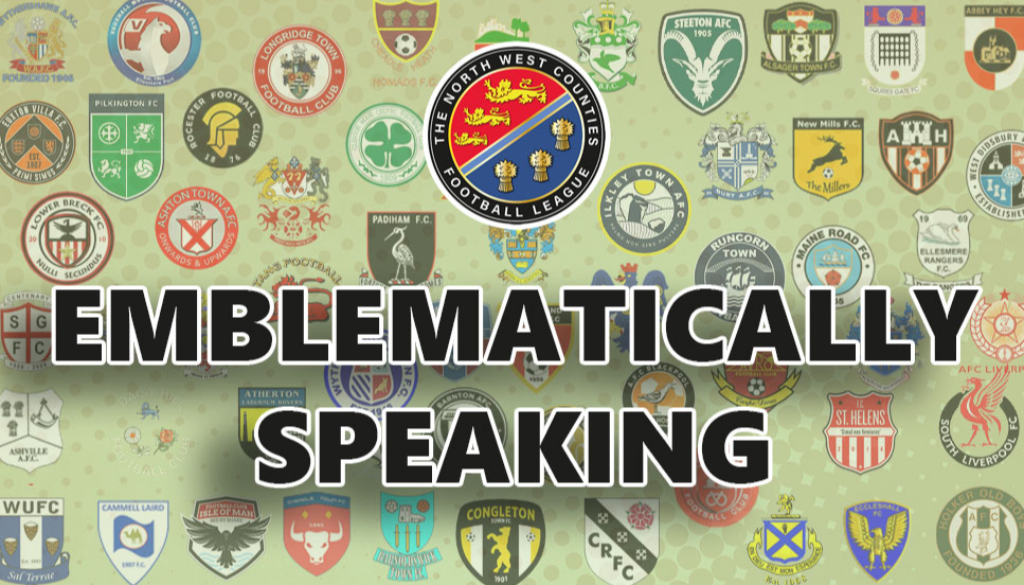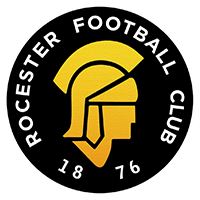
Emblematically Speaking - Rocester
Thu 24th November 2022 | Rocester | By Martin Fallon
From time to time we highlight famous people from the town represented by the football club under the spotlight. In the case of Rocester I was really hoping that the club playing colours were blue. Why, you may ask and this refers to a native of Rocester by the name of Graeme Edge. Graeme was the drummer and one of the songwriters of the band The Moody Blues – days of future passed, whatever that may mean! That the change colours of Rocester FC are Blue and White would be simply co-incidental I suspect.
We can of course look to the main playing colours of Amber and Black being in some way representative of the colours of JCB – the significant local employer – but the equipment made by JCB is so distinctive in colour that it has its own reference number – RAL 1007 - and, in any case, the club was around well before JCB.
But back to the theme of the club emblem the above representing one of the not infrequent diversions from the main theme – enigma(tic) variations perhaps but a certain classical music composer got there well before me and no, not the same chap who is currently Captain of the South Africa Men’s Test Cricket team!
As we can see, Rocester FC are represented by a relatively simple emblem behind which is plenty of history. We readily see the year of formation of the club – a very long time ago – and the name. The central device on a simple roundel is a helmeted Roman Head.
It is not necessary in this context to chronicle Roman times in Britain – enough books have been written about that - but simply to say that Rocester was an intermediate point between Derby (Derventio) and Newcastle-under Lyme and a fort was founded at Rocester around 69AD. The Roman road was known as Long Lane and provided a route through into what is now Cheshire at Middlewich. Handy for the important Roman City of Chester (Deva).
With reference to the playing colours – see above - the club was known locally as “The Black & Amber” and had an earlier badge than the one we see today which was essentially the Stafford Knot with the letters R. F and C in the three loops. We will have more to say on the Stafford Knot later in this series.
In 1987 when the club moved to its current ground, the land had to undergo an archaeological dig (carried out by Birmingham University) before it could be built upon. A small number of Roman artefacts were uncovered, and as a result the club took on the nickname of “The Romans”. The design of the badge reflects this and is designed to be simple, bold and eye-catching which it most certainly is.
It is of interest to note that the club designed an enamel badge encompassing more detail with two rivers and bridges representing the Churnet and the Dove rivers that flow either side of the village, and a Roman Centurion, however that design was considered to be a little bit complicated and there are no plans to replace the current emblem.
Here we see another example of the modern trend for instantly recognisable emblems although, old traditionalist that I am, I would love to have seen the more complicated one.
With thanks to Barry Smith of Rocester FC for his contribution to this article.
 Emblematically Speaking - Rocester
Emblematically Speaking - Rocester
Thu 24th November 2022 | Rocester
By Martin Fallon

From time to time we highlight famous people from the town represented by the football club under the spotlight. In the case of Rocester I was really hoping that the club playing colours were blue. Why, you may ask and this refers to a native of Rocester by the name of Graeme Edge. Graeme was the drummer and one of the songwriters of the band The Moody Blues – days of future passed, whatever that may mean! That the change colours of Rocester FC are Blue and White would be simply co-incidental I suspect.
We can of course look to the main playing colours of Amber and Black being in some way representative of the colours of JCB – the significant local employer – but the equipment made by JCB is so distinctive in colour that it has its own reference number – RAL 1007 - and, in any case, the club was around well before JCB.
But back to the theme of the club emblem the above representing one of the not infrequent diversions from the main theme – enigma(tic) variations perhaps but a certain classical music composer got there well before me and no, not the same chap who is currently Captain of the South Africa Men’s Test Cricket team!
As we can see, Rocester FC are represented by a relatively simple emblem behind which is plenty of history. We readily see the year of formation of the club – a very long time ago – and the name. The central device on a simple roundel is a helmeted Roman Head.
It is not necessary in this context to chronicle Roman times in Britain – enough books have been written about that - but simply to say that Rocester was an intermediate point between Derby (Derventio) and Newcastle-under Lyme and a fort was founded at Rocester around 69AD. The Roman road was known as Long Lane and provided a route through into what is now Cheshire at Middlewich. Handy for the important Roman City of Chester (Deva).
With reference to the playing colours – see above - the club was known locally as “The Black & Amber” and had an earlier badge than the one we see today which was essentially the Stafford Knot with the letters R. F and C in the three loops. We will have more to say on the Stafford Knot later in this series.
In 1987 when the club moved to its current ground, the land had to undergo an archaeological dig (carried out by Birmingham University) before it could be built upon. A small number of Roman artefacts were uncovered, and as a result the club took on the nickname of “The Romans”. The design of the badge reflects this and is designed to be simple, bold and eye-catching which it most certainly is.
It is of interest to note that the club designed an enamel badge encompassing more detail with two rivers and bridges representing the Churnet and the Dove rivers that flow either side of the village, and a Roman Centurion, however that design was considered to be a little bit complicated and there are no plans to replace the current emblem.
Here we see another example of the modern trend for instantly recognisable emblems although, old traditionalist that I am, I would love to have seen the more complicated one.
With thanks to Barry Smith of Rocester FC for his contribution to this article.


